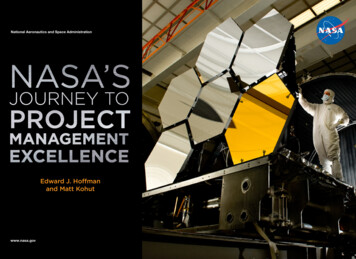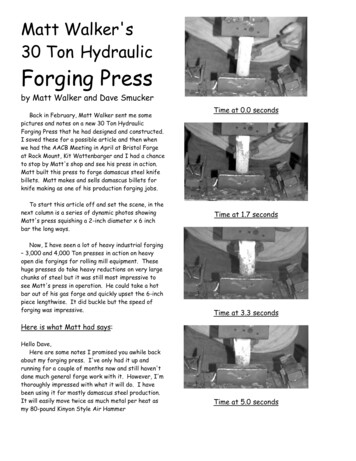
Transcription
National Aeronautics and Space AdministrationEdward J. Hoffmanand Matt Kohutwww.nasa.govChapter OneWhy AA ProjectProject Academy?Academy? BecauseBecause FailureFailure isis anan Option.Option.Whyi
TablE of ConTEnTsChapter oneWhy A Project Academy? Because Failure Is an Option. . 1Chapter TwoComplex Projects and The Rise of Project Academies . 8Chapter ThreeBuilding Individual Capability . 15Chapter fourBuilding High-Performance Team Capability . 26Chapter fiveKnowledge Services: Building Organizational Capability . 33Chapter sixReflections and Future Directions . 42Why A Project Academy? Because Failure is an Option.ii
Chapter OneWHy a ProJECTaCadEMy?bECausE failurEis an oPTion.Ever tried. Ever failed. No matter.Try again. Fail again. Fail better.— Samuel BeckettAs a cold front approached Florida’s Atlantic coaston the afternoon of Monday, January 27, 1986, theweather was on the mind of everyone associated withNASA’s space shuttle program. Shortly after noon, theMission Management Team scrubbed the scheduledlaunch of space shuttle Challenger on mission STS51L due to high winds, after experiencing a delay inthe countdown earlier that morning due to a minormechanical problem. It was the fourth launch delay infive days. The forecast for Tuesday called for unseasonably frigid temperatures, with the mercury predicted to dip to 18 F overnight.Chapter OneWhy AA ProjectProject Academy?Academy? BecauseBecause FailureFailure isis anan Option.Option.Why1
STS-51L would be the twenty-fifth space shuttlemission, and the twenty-first since President Reaganhad declared the shuttle “operational” after four testflights. Originally slated for launch in July 1985, STS51L was rescheduled for November 1985 and thenJanuary 1986. The crew of seven included ChristaMcAuliffe, a school teacher from New Hampshirewho had been selected from among 11,000 applicants to serve as the first teacher in space and thefirst citizen passenger on a space shuttle mission.Interest in the McAuliffe story had led to a wave ofpublicity for the flight. CNN planned to provide livecoverage of the launch on cable television.On Monday afternoon after the scrubbed launch, ateam of engineers at Morton Thiokol, NASA’s contractor for the solid rocket boosters that provide themajority of the liftoff thrust for the shuttle, held ameeting to discuss the potential impact of cold temperatures on the hardware. The focus of their discussion was the O-rings that served as seals in the jointsbetween the segments of the solid rocket boosters.The concern was that at the predicted temperatures,the rubber-like O-rings would lose resiliency andfail to create a seal. Thiokol engineers had tested theO-rings at various temperatures and found troublingperformance data at temperatures of 50o F. Lowertemperatures would only make the problem worse.The meeting, which took place at Thiokol’s facilityin Utah, lasted roughly an hour, with the engineersagreeing there was a real danger of mission failure fora launch at the predicted temperatures.Managers set up an early evening teleconferencewith Thiokol and NASA representatives fromKennedy Space Center and Marshall Space FlightChapterChapter OneOneCenter, which had responsibility for the shuttle’spropulsion systems, including its solid rocketboosters. During this 45-minute call, some NASAofficials thought that representatives from Thiokolwere saying the launch should be delayed, whileothers thought Thiokol was raising issues but notmaking a formal recommendation to delay. A second call was scheduled for a few hours later so thatThiokol could fax its engineering documentationto NASA officials.HA 1980 study led by Langley Research CenterDirector Donald P. Hearth identified four majorreasons for cost/schedule growth in several NASAprojects: Technical complexity of projects. Inadequate definition prior to NASA’s budgetdecision and external commitment. Effect of NASA’s tendency to select on thebasis of bid price and low contractor bids.More engineers and managers participated in thesecond teleconference, which began at 8:45 PM.Engineers from Thiokol reviewed data from previousflights and evidence of erosion of the O-rings, andrecommended not launching at temperatures below53o F, which was the lowest temperature at a previous shuttle launch. Managers from NASA expressedsurprise at this recommendation, pointing out thatit represented a sweeping change in the launch criteria for the solid rocket boosters. Thiokol and NASAthen took a break from the teleconference and heldoffline caucuses with their own teams. Poor tracking of contractor accomplishmentsWhen the call resumed, Thiokol’s vice president incharge of booster programs said that Thiokol hadreassessed the data and found it inconclusive. Heread a written rationale recommending launch asthe company’s official position, which was later sentto NASA. The call ended shortly after 11 PM. Unrealistic dependence on unprovenAs predicted, the next day was unusually cold. Finallaunch preparations proceeded apace. At 11:38AM, the space shuttle Challenger lifted off into aclear blue sky. The temperature on the launch padwas 36o F. Just over 58 seconds into the launch Scope additions due to “requirements creep”Why AA ProjectProject Academy?Academy? BecauseBecause FailureFailure isis anan Option.Option.Whyagainst approved plans in a timely fashion.JaIn the summer of 1992, the NASA Administratorasked Marshall Space Flight Center Director JackLee to lead a six-month agency-wide study of 30recent NASA projects. Lee’s team identified eightfactors that drive program costs and technicalrisks: Inadequate Phase B definition (i.e., beforePreliminary Design Review)technology Annual funding instability Complex organizational structure, includingmultiple unclear interfaces Cost estimates that are often misused Schedule slips Acquisition strategy that does not promote costcontainment2
sequence, a flame became visible in the area of theright solid rocket booster. In the next few seconds,the flame grew into a well-defined plume, and thevehicle’s control system made adjustments to counter its physical forces. There was a sudden changein the shape and color of the flame, indicating thepresence of hydrogen from the shuttle’s enormousExternal Tank, which was now leaking. At 73 seconds, the vehicle erupted in a ball of fire, and theshuttle orbiter broke into several large sections. Thecrew did not survive.1Why do Projects FAil?Why do projects fail? There are plenty of opinionson this subject. A quick Google search on the phrase“why projects fail” turns up hundreds of thousandsof hits. Scholars of project management have yet toreach a consensus. Some propose that project failureis under-theorized, while others say that an emphasis on success and failure is narrow and counterproductive.2 For a publicly accountable organizationlike NASA, understanding the causes of project failure is not an abstract concern. Rather, it is critical tomission success and the agency’s continuous growthas a learning organization.1This brief summary of events leading up to the Challenger accident draws from thefollowing sources: “Report of the Presidential Commission on the Space Shuttle Challenger Accident” (Rogers Commission Report), Chapter V, accessed 30 June 2011 athttp://history.nasa.gov/rogersrep/v1ch5.htm; U.S. House of Representatives, Ninetyninth Congress, Second Session, “Investigation of the Challenger Accident: Reportof the Committee on Science and Technology,” (Washington, D.C.: U.S. GovernmentPrinting Office 64-420 O, 1986), “Hearing Before the Committee on Science, Spaceand Technology,” U.S. House of Representatives, One Hundredth Congress, First Session, (Washington, D.C.: U.S. Government Printing Office 73-363, February 26, 1987),and Diane Vaughan, The Challenger Launch Decision: Risky Technology, Culture, andDeviance at NASA (Chicago: University of Chicago Press, 1986), pp. 1-7.Chapter OneNASA has done several internal studies of projectmanagement, including some that have attemptedto target why projects fail to meet cost and schedulecriteria.This list offers some insights about the nature ofproject failure. A closer look at each reveals a common denominator.The federal government has also examined projectperformance issues. For the past two decades, theGovernment Accountability Office (GAO) has studied how well government agencies manage acquisition projects. Every two years GAO updates its“High-Risk Series,” which identifies governmentprograms at risk. Based on these studies, GAO hascome to its own conclusions about governmentproject management:GAo hiGh risk series“GAO’s work has shown that agencies confrontseveral interrelated challenges, includingseparating wants from needs; executingacquisition programs within available fundingand established timeframes; using soundcontracting arrangements with appropriateincentives and effective oversight; assuringthat contractors are used only in appropriatecircumstances and play proper roles; andsustaining a capable and accountableacquisition workforce.” 32See, for example, Svetlana Cicmil, Damian Hodgson, Monica Lindgren and JohannPackendorff, “Project Management Behind the Façade,” ephemera 9(2) (2004) 78-92;and Jonas Söderlund, “Building theories of project management: past research, futurequestions,” International Journal of Project Management 22 (2004) 183–191.3U.S. General Accountability Office website, accessed 21 June 2010 at: http://www.gao.gov/highrisk/challenges/acquisition management/home acquisition management.phpWhy AA ProjectProject Academy?Academy? BecauseBecause FailureFailure isis anan Option.Option.WhyThe February 2011 GAO High Risk Series hadfour entries under “Managing Federal ContractingMore Effectively.” (Dates indicate the year the itemwas added to the high-risk list.) Department of Defense Contract Management(1992) Department of Energy Contract Managementfor the National Nuclear Security Administrationand Office of Environmental Management(1990) NASA Acquisition Management (1990) Management of Interagency Contracting (2005)The inability to separate wants from needs is fundamentally a communication failure that can compound at multiple levels. A project team solicits its“needs” — the requirements for a project — from itscustomer or client. Requirements definition, a critical factor in project success, is essentially an iterativeconversation between the customer and the project team to determine what the customer is askingfor and how the project team can deliver it. As theproject team develops its approach, it will inevitablysuggest options to the customer, all of which havecost, schedule or performance implications. Some ofthose options may include the project team’s “wants”— the tools, resources, or flexibilities it would like tohave to execute the project. When the project leaderallows the team to confuse wants with needs, the3
team cannot deliver optimal performance, and thecustomer always loses. At its core, this represents afailure of a project leader to define reality for the teamand communicate that reality clearly.The challenge of “executing acquisition programswith available funding and within establishedtimeframes” is a long way of saying that projectsfail because they don’t meet cost and schedule constraints. Along with technical performance, theseare the bedrock concerns of traditional projectmanagement. There is a well-known tendency forproject teams to underestimate costs in the proposal process, regardless of whether the project isa spacecraft or a skyscraper. Decades of overrunshave demonstrated that many, if not most, teamstend to be overly optimistic in the project formulation phase. As early as 1959, a report by the RANDCorporation concluded that early estimates on projects are “strongly ‘biased’ toward overoptimism.”4This hasn’t changed in the past fifty years. Despiteoverwhelming historical data, project teams convince themselves that they can work smarter, faster,and better than other teams have in the past. As aresult, they underestimate cost and schedule fromDay 1 of the project life cycle, and inevitably fail tomeet their unrealistic goals. Overly optimistic estimates are another example of a leadership failure todefine reality for the team.The next three items — using sound contractingarrangements, employing contractors effectivelyand appropriately, and sustaining a capable and4A.W. Marshall and W.H. Meckling, “Predictability of the Costs, Time, and Success ofDevelopments,” RAND P-1821, October 14, 1959 (revised December 11, 1959), p. 1.Chapter Oneaccountable acquisition workforce — are all abouthow to use people effectively. Do contracts providepeople with the right incentives? Are the right people tasked with the right work? Is the workforce upto the job?What do GAO’s high-level conclusions, based on twodecades of research and analysis, tell us about thenature of project failure? Simply put, project failureis a people problem. Separating needs from wantsis a problem familiar to anyone who has bought ahouse or even a car — it’s hardly unique to projects. Overly rosy cost and schedule projections stemfrom errors in judgment similar to those studiedby behavioral economists and psychologists abouthow people perceive risk. Decisions about the use ofcontractors and in-house staff (including make-buyconsiderations) boil down to which people to use ona project. The success or failure of a project dependswholly on decisions and actions taken by people.Even if the decision-makers are not part of the formal project team — they may be external stakeholders — the implications are the same.The GAO list cited above doesn’t claim to be comprehensive or reflect the entirety of GAO’s knowledge about projects. (GAO typically looks at onedepartment, agency, or class of projects at a time,e.g., major weapons systems or space systems developments.) Many other analysts have developed theirown lists of “usual suspects,” which include inadequate risk management, the introduction of new orimmature technologies, lack of corporate sponsorship, inadequate processes or process implementation, all varieties of communication breakdowns,and a lack of qualified talent.Why AA ProjectProject Academy?Academy? BecauseBecause FailureFailure isis anan Option.Option.WhyThese are all important reasons that projects fail.Each can be reduced to one of the following typesof failures: to define reality accurately, communicate, or get the right people for the job. StephenB. Johnson, a historian and NASA engineer, hasestimated that “80 to 95 percent of failures areultimately due to human error or miscommunication.”5 With that in mind, what can be done toimprove project outcomes?Our subject is the importance of developing astrategy to address the human dimension of complex projects. By removing one word from the lastchallenge on GAO’s list, we arrive at a broader goalthat’s essential for any successful project-basedorganization: sustaining a capable and accountableworkforce.This emphasis on the human dimension callsfor a full disclosure of our basic philosophy andassumptions.1. the practitioner knows best. Academicresearchers, policy experts, and other thought leaderscan provide important insights and a diversity of perspectives, but the best way to develop project capability within an organization is to talk to people whomanage or work on projects. Their driving passion isproject success. Daron Roberts, assistant defensivecoordinator for the Detroit Lions, told Kohut thatpro football players are interested in anything thatwill give them an edge in Sunday match-ups againstopposing teams. “Players want the info that’s going5Stephen B. Johnson, “Success, Failure, and NASA Culture,” ASK Magazine (Fall 2008),accessed 30 June 2010 at: http://askmagazine.nasa.gov/issues/32/32i success failure nasa culture.html4
to enable them to be successful on Sundays. Period.”Project practitioners bring the same sense of relentless focus to their work. They have little patience forabstractions or theories unless they can see a tangiblebenefit in terms of project performance.2. experience is the best teacher. Practitionershave told us many times over that 85 to 90 percentof learning takes place on the job. This assumptioninforms every decision about how best to design learning opportunities for a project-based organization.Academic work and training courses provide a crucial foundation, but they are no substitute for learning by doing. Our colleague Larry Prusak, Editor-inChief of ASK Magazine, uses a personal anecdote tounderscore this point. As a baseball player in juniorhigh school, Larry was a lousy hitter who wanted toimprove his performance. His father bought him TedWilliams’s book The Art of Hitting, which Larry proceeded to read twice, only to find that it didn’t makehim a better hitter. “The skills involved are too complex and subtle, too internal; they can’t be expressedin words that can be put to much use,” Larry writes.The same is true about leading a complex project —the skills are too complex, subtle, and internal to bewritten down in a how-to guide or codified in a waythat can be reproduced outside of a project setting.3. context is king. What works in one time andplace may be useless in another. At NASA there aremany examples resulting from the diversity of theagency’s missions. Cindy Hernandez, a softwareengineer who worked on modeling the Orion crewcapsule at Johnson Space Center, did a developmentalassignment on a software project for the F-18 aircraftat Dryden Flight Research Center. Much of what sheChapter Oneknew from her experience with spacecraft was simply not relevant in this context, which meant she hadto learn a new way of thinking. Similarly, each careerstage has different learning needs. For example, engineers fresh out of college are more receptive to coursework than mid-career practitioners with twenty yearsof experience. Early career learning at NASA requiresbuilding a foundation of strong technical skills, whilelater development often emphasizes managementand leadership. In short, a one-size-fits-all model forlearning cannot meet all needs.4. Performance happens at the team level.Complex projects are always team endeavors thatdepend on a diversity of knowledge and talent. Afterthe space shuttle experienced an in-flight anomalyduring the launch of STS-126 in November 2008, ittook the coordinated efforts of roughly 1000 peopleworking at NASA and contractor centers across thecountry to understand what had happened and whatrisk this might pose to future shuttle flights. Expertsin disciplines ranging from ballistics to computational fluid dynamics brought different knowledgeand perspectives to bear on a problem that did nothave a “silver bullet” answer. (We’ll explore this casein detail in chapter 5.) The centrality of learning in theteam context becomes critically important when weexamine the shortcomings of traditional approachesto learning in project-based organizations.needs to account for individual competence, teamperformance, and the effective sharing of knowledge across the organization.Project failure is our starting point because it isa proven catalyst for learning.6 At NASA this iswell understood as a result of painful lessons likeChallenger. The quote attributed to Gene Krantz inthe film Apollo 13 — “Failure is not an option” — istruly inspirational in a moment of operational crisis.But on large-scale projects that stretch over monthsor years, failure is an option. History has shown thisto be true time and again, at NASA and elsewhere.“A large organization can emphasize toits engineers that talking and thinkingabout failure are not signs of pessimism,but are ways to keep the principal goal— the obviation of failure — in theforefront. Success is best achieved bybeing fully aware of what can go wrongin a design — and designing against itshappening.”Dr. Henry Petroski, Duke University,ASK OCE e-newsletter Vol. 1, Issue 105. A project workforce needs an integratedlearning model. Workforce development effortsin project-based organizations typically focus exclusively on training for individuals. Given the criticality of team performance and knowledge sharing(as mentioned above), a robust development modelWhy AA ProjectProject Academy?Academy? BecauseBecause FailureFailure isis anan Option.Option.Why6Through an empirical study of the global orbital launch vehicle industry since itsinception in the 1950s, Peter M. Madsen and Vinit Desai conclude that “learning fromlarge failures, rather than learning from success or small failures, primarily drives organizational improvement.” See Peter M. Madsen and Vinit Desai, “Failing to Learn?The Effects of Failure and Success on Organizational Learning in the Global LaunchVehicle Industry,” Academy of Management Journal 2010, Vol. 53, No. 3, p. 472.5
In the aftermath of Challenger, NASA commissioned retired Air Force General Samuel C. Phillips,the former director of the Apollo program, to leada NASA Management Study Group and makerecommendations to the NASA Administrator.Among other things, his report called for theagency to “strengthen agency-wide leadership indeveloping and managing people.” This led directlyto the establishment in 1989 of the Program andProject Management Initiative. Sponsored bythen-Deputy Administrator J. R. Thompson, itconsisted of a series of training courses in the fundamentals of project management knowledge. Thiswas the direct precursor to today’s NASA Academyof Program/Project & Engineering Leadership. Inshort, the project academy is a legacy of NASA’scommitment to learn from the Challenger failure.The response to the Challenger accident was astarting point that focused on building individualcompetence. A decade later, NASA suffered theback-to-back failures of the Mars Climate Orbiterand the Mars Polar Lander. In the aftermath ofthose setbacks, NASA Administrator Dan Goldinmade it clear that he expected the Academy todevelop the capability of teams as well as individuals. It was a wake-up call that helped set theAcademy on its present course of offering directsupport to project teams in the field. Similarly,a report by GAO in January 2002 that lookedat the Mars failures found “fundamental weaknesses in the collection and sharing of lessonslearned agency-wide.” 7 This spurred the Academyto expand the scope of its knowledge sharingefforts. After the Columbia accident in 2003,PrinciPAl recommendAtions oFthe nAsA mAnAGement study GrouP (1986)1. Establish strong headquarters program direction for each major NASA program, with clear assignment ofresponsibilities to the NASA centers involved.2. Improve the discipline and responsiveness to problems of the program management system.3. Place shuttle and space station programs under a single Associate Administrator when the Administrator issatisfied that recovery of the shuttle will not thereby be compromised.4. Increase management emphasis on space flight operations.5. Place special management emphasis on establishing NASA world-class leadership in advanced technologyin selected areas of both space and aeronautical technology.the Columbia Accident Investigation Board concluded that “NASA’s current organization hasnot demonstrated the characteristics of a learningorganization.” 8 The Academy increased its support to teams and looked for new ways to addresscommunications, organizational learning, andtechnical excellence. (Later chapters will go intodetail about the Academy’s activities to promoteindividual, team, and organizational learning.)In short, the Academy’s core initiatives have theirroots in failure.One of the reasons for the gap that the Academy hassought to fill at NASA is that project managementhas evolved greatly over the past fifty years, butmethodologies for developing practitioners have notkept pace. Even as project complexity has increasedsignificantly in recent decades, most professionaldevelopment efforts have remained focused on theiron triangle of cost, schedule, and technical performance. (We’ll talk more about project complexity inthe next chapter.)Advances in technology are just one piece of the puzzle. Global supply chains, virtual teams, and the roleof the customer are all different, to name just a fewthings. Cost, schedule, and technical performanceare still critical, but the picture is significantly morechallenging.6. Establish a formal planning process within NASA to enunciate long-range goals and lay out program,institutional, and financial plans for meeting them.7. Strengthen agency-wide leadership in developing and managing people, facilities, equipment, and otherinstitutional resources.Chapter OneWhy AA ProjectProject Academy?Academy? BecauseBecause FailureFailure isis anan Option.Option.Why7U.S. General Accountability Office, “NASA: Better Mechanisms Needed for SharingLessons Learned,” GAO-02-195. Accessed 30 June 2010 at: www.gao.gov/new.items/d02195.pdf8Columbia Accident Investigation Board, Report Volume 1 (Washington, D.C.: Government Printing Office, August 2003), p. 12.6
“The incorporation of new technologyin a megaproject almost ensures thatthe project will make more mistakesthan money. The use of new technologyis the only factor that is associated withbad results in all three dimensions: costgrowth, schedule slippage, and performance shortfalls.”— Edward W. Merrow,“Understanding the Outcomes of Megaprojects: AQuantitative Analysis of Very Large Civilian Projects,”RAND Corporation (Santa Monica, CA, 1988).Chapter OneFortunately, there has been growing interest inthe global project management community innew ways of building organizational capability.This book will offer an overview of the landscapefor complex projects today as well as an accountof some of the strategies and methods employedby the NASA Academy of Program/Project &Engineering Leadership to help develop theproject management workforce at NASA. Theapproaches described here represent a way — notthe way — to build capability. Other organizations may find very different solutions that betterfit their needs.Hoffman learned this lesson while working atGoddard Space Flight Center in the late 1980s beforeWhy AA ProjectProject Academy?Academy? BecauseBecause FailureFailure isis anan Option.Option.Whybecoming involved with the precursor to the project academy. At one point he met with the CenterDirector to suggest different courses and offeringsthat might be valuable for the workforce.“This isn’t what I need,” the Center Director toldHoffman. “You know what I need? I need somethingthat’s going to tell me when my projects are gettinginto trouble. And then I need something that canturn them around. When you have that, come backto me.”The direct quote above may have been burnishedby time, but the sentiment remains correct. Theonly measure that matters in the end is projectsuccess.7
Chapter TwoCoMPlExProJECTsand THE risEof ProJECTaCadEMiEsIf there is a sense of reality, there mustalso be a sense of possibility.— Robert MusilSaturn and its rings have fascinated astronomers sinceGalileo first observed it with his telescope in 1610.Nearly 50 years later, Dutch astronomer ChristiaanHuygens, using a more sophisticated telescope thanGalileo had, was able to identify the planet’s rings aswell as its moon Titan. Two decades after Huygens,Jean-Dominique Cassini discovered four more moonsand the largest gap between the planet’s rings.Why A Project Academy? Because Failure is an Option.8
Three centuries later, Cassini and Huygens servedas the inspiration for two spacecraft that soughtto explore Saturn and its moons up close. CassiniHuygens, a partnership among NASA, the EuropeanSpace Agency (ESA), and the Italian Space Agency,began a 1.5-billion km voyage from Earth inOctober 1997. The missions were ambitious. NASA’sCassini spacecraft would ferry ESA’s Huygens probeto Titan, Saturn’s largest moon, and release it for adramatic descent to the lunar surface. Cassini wouldthen continue on to conduct detailed observationsof Saturn, its rings, and its moons.By any standard, this was a complex undertaking.The science team alone included 260 scientists in17 countries spanning 10 time zones. All the scientists involved wanted to maximize the opportunityto conduct experiments on this once-in-a-lifetimemission. All were equally aware that on a flagshipmission like this, runaway costs would likely lead tode-scoping — the mission would be simplified, andsome science instruments would get cut.With 18 instruments slated to fly on the spacecraft,project manager Dennis Matson developed a freemarket system to manage payload reserves. Afternegotiating contracts with each of the PrincipalInvestigators (PIs) for the instruments, he distributed the payload margin for each instrument — thedollars (per fiscal year), mass (in kg), power (inwatts), and data rate to the spacecraft bus (in kilobytes per second) — directly to the PIs. This gavethe PIs control over the fate of their respectiveinstruments. Matson and his team then establisheda mechanism that enabled the PIs to trade thoseresources with each other, with all offers and tradesCrecorded electronically. (The project manager, project scientist, and payload manager maintained vetoauthority over any trade.) The trades became quitecomplex, sometimes involving three or four partiesand a “broker” to facilitate multiparty exchanges.The “Casino Mission,” as the teams dubbed it, established a win-win ethos among the PIs and a strongsense of teamwork. In the end, all 18 planned instruments ended up flying on the spacecraft.As Cassini-Huygens traveled through space on itsjourney to Saturn, a full test of the data communication system between the Cassini and Huygenssp
boosters. During this 45-minute call, some NASA officials thought that representatives from Thiokol were saying the launch should be delayed, while others thought Thiokol was raising issues but not making a formal recommendation to delay. A sec-ond call was scheduled for a few hours late










